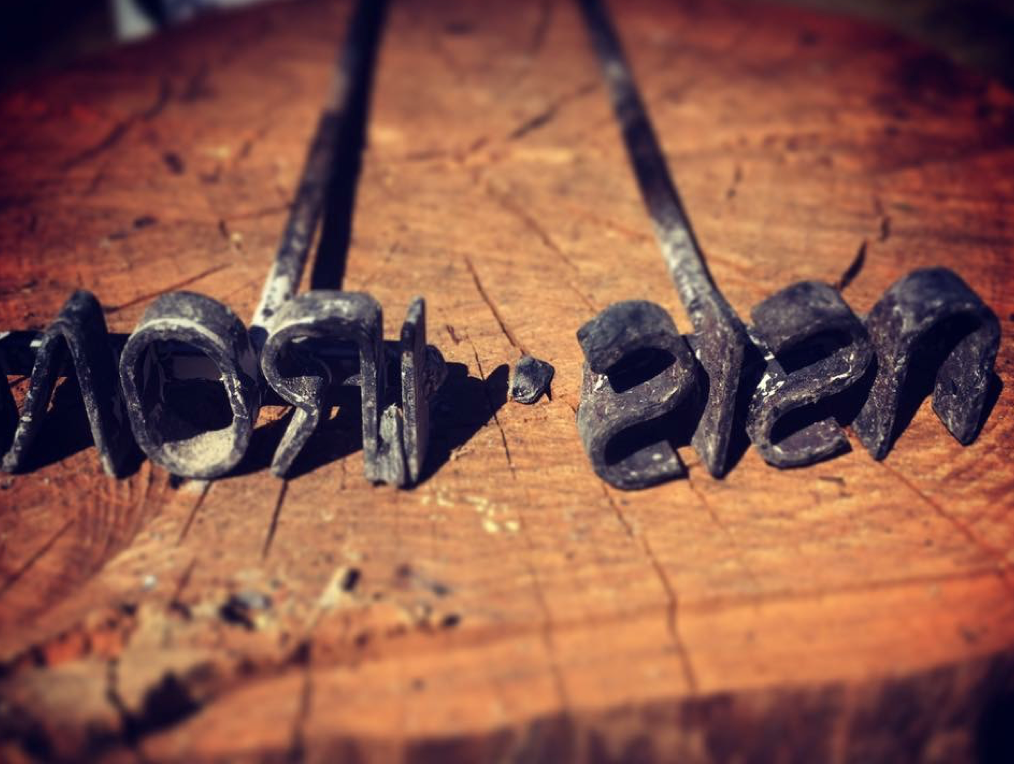
The SISU IRON is an epic 30+ hour variety endurance event that should strike fear in your heart. It’s reputation is that it will challenge you in ways that you haven’t been challenged before, and there is no way for you to predict what the key challenges are. The organizer’s goal is to find the chink in the armor of even the strongest athletes. They will then force you to address that weakness in order to finish. As Don Devaney said at the beginning of this year’s Iron, he has not found someone without a chink.
As an experienced endurance athlete and past Ironman (more on that below), I approached this event with tenuous confidence. I had confidence that I could finish, but I was fearful of what I would need to do to get there. Other endurance races set out clear parameters for success: you must cover 100 miles in under 36 hours or your goal is to complete as many miles as possible in 24 hours. In registering for the Iron, you place your trust in the organizers that they will test you, and you’ll find the motivation to rise to their standard.
The rough structure of the Iron is similar to an adventure race or Spartan Hurricane Heat. The event is split into stages. You must complete the required work for each stage before progressing to the next stage. If you don’t complete the work in the allotted time, referred to as a “time hack,” your race ends there. Past finishing the event, there are tokens and rewards that you can accumulate with the hope that they will assist you in passing future time hacks. The time hacks tend to get progressively harder as you get deeper into the event.
In the rest of this race recap, I’ll give you insight into what the IRON is so that you can consider participating and show you the struggle that makes us stronger.
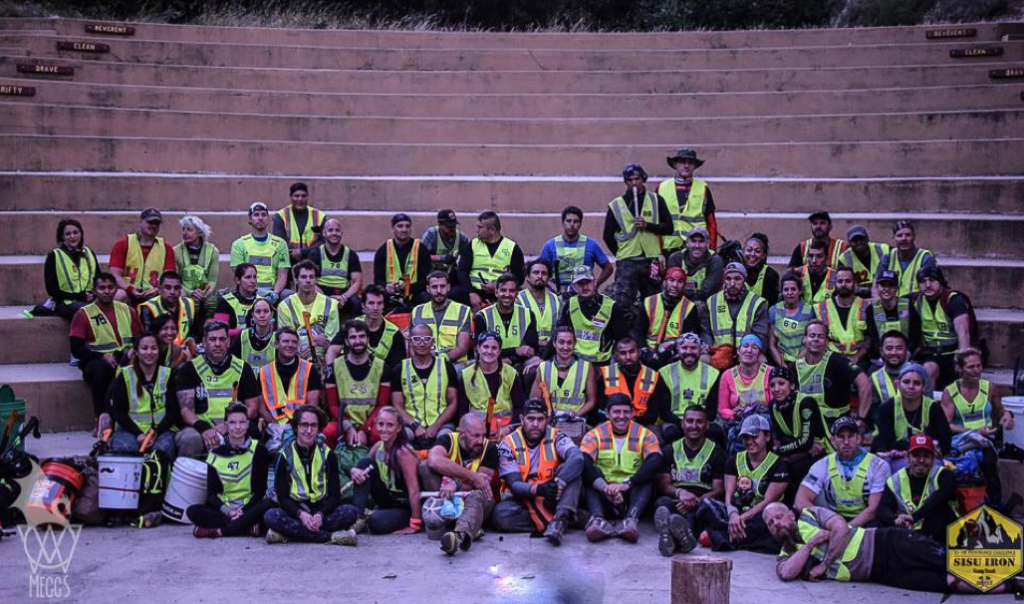
When someone tells you that the Iron starts on Friday, they’re lying to you. The IRON starts when you sign up. Prior to the event, you must accumulate your required gear list that tends to include some awkward item that you must construct yourself. This year, our special item was a 12-inch long and 4-inch diameter log then fashion a flat 8-10 inch face of exposed wood (directions here). I was lucky enough to find an appropriate log while on an easy run, then carried it back 2 miles to my house. I used my ax and saw to make it clean, pretty and easy to carry. In addition, you should monitor the Facebook group for additional challenges like solving riddles posed by the cruel mind of Don Devaney.
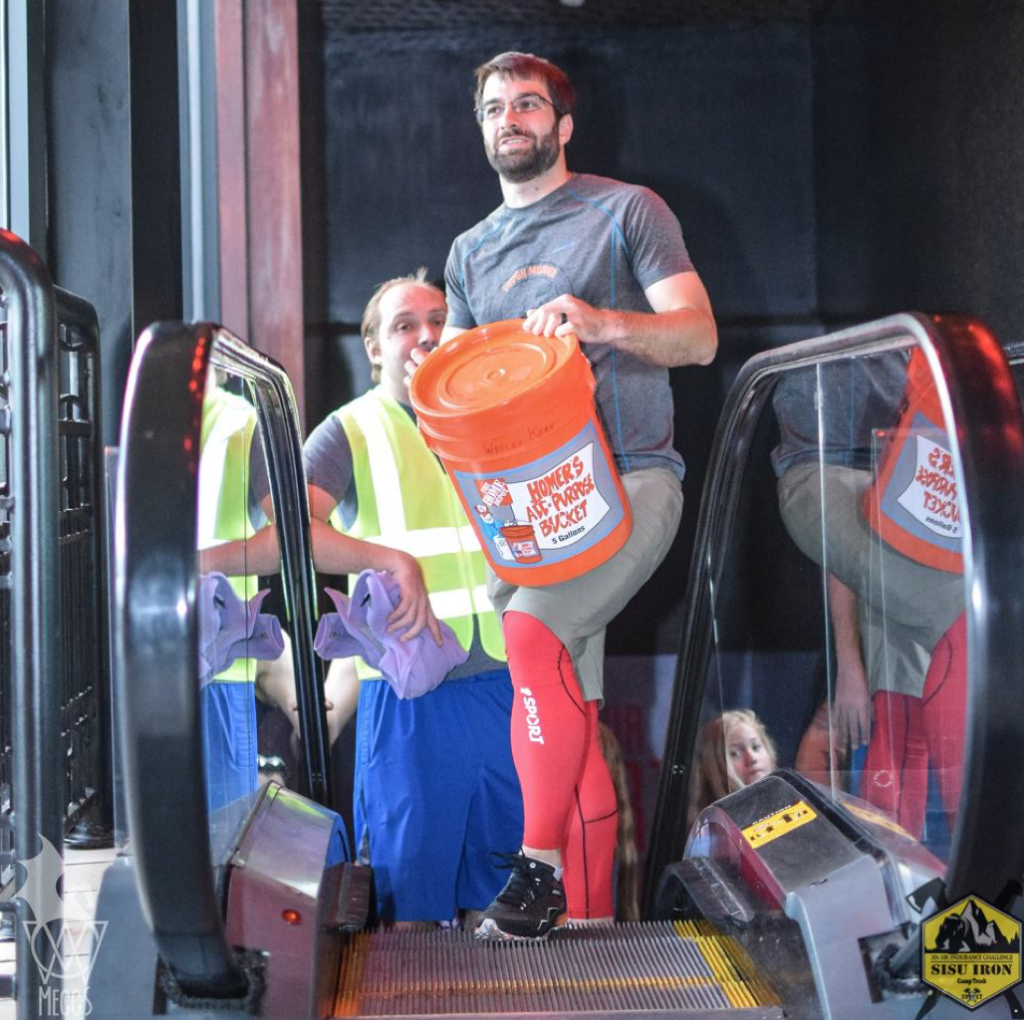
Again, if someone tells you that the Iron starts on Friday except for the gear list, they’re still lying to you. It really starts at pre-registration on Thursday night. Pre-registration occurs on the roof of Dave & Buster’s in Arcadia and includes lots of burpees, plyometric exercises, random relay races (like running with a potato between your legs, then squatting a potato into a bucket) and other miscellaneous activities. Please don’t be late because being late will cause your fellow racers to do more work. Overall, the pre-registration is a fun time with friends. Expect to work out for 2-3 hours, and eat before you get there, or show up early to eat. During pre-registration we received a maraschino cherry that could assist us during the Iron. If you do not do pre-registration, you may need to do additional work on Friday during registration to earn your spot in the Iron.
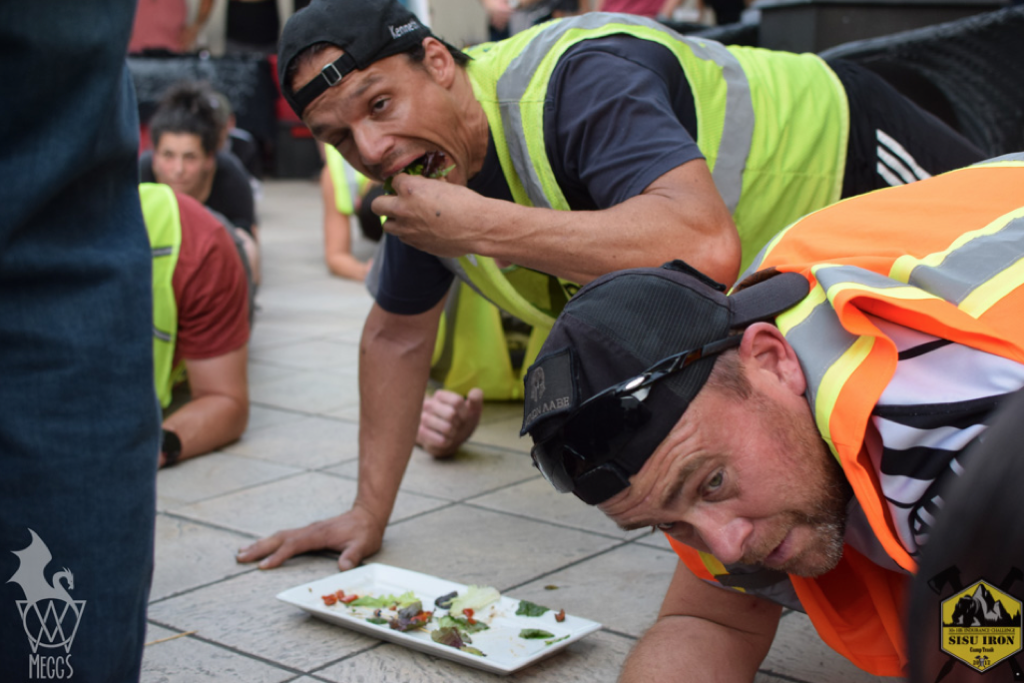
On Friday, we were allowed to be on-site at 5pm and the event officially started at 7pm. You don’t want to carry all your resources for a 30+ hour event on your person the whole time, so the strategy is to pay for VIP parking or set up a tent on-site with extra gear including supplemental water, Honey Badger, Tailwind, and food. I also pack changes of clothing, cold gear, and extra headlamps & batteries. However, the instant we showed up on site, Don Devaney tasked us with retrieving large logs and bringing them down to the main camp (Strava activity). The challenge is that you needed to help, but you also needed to make sure you had time to set up your tent. Don’t expect to have much time to organize, so be organized before you get there.
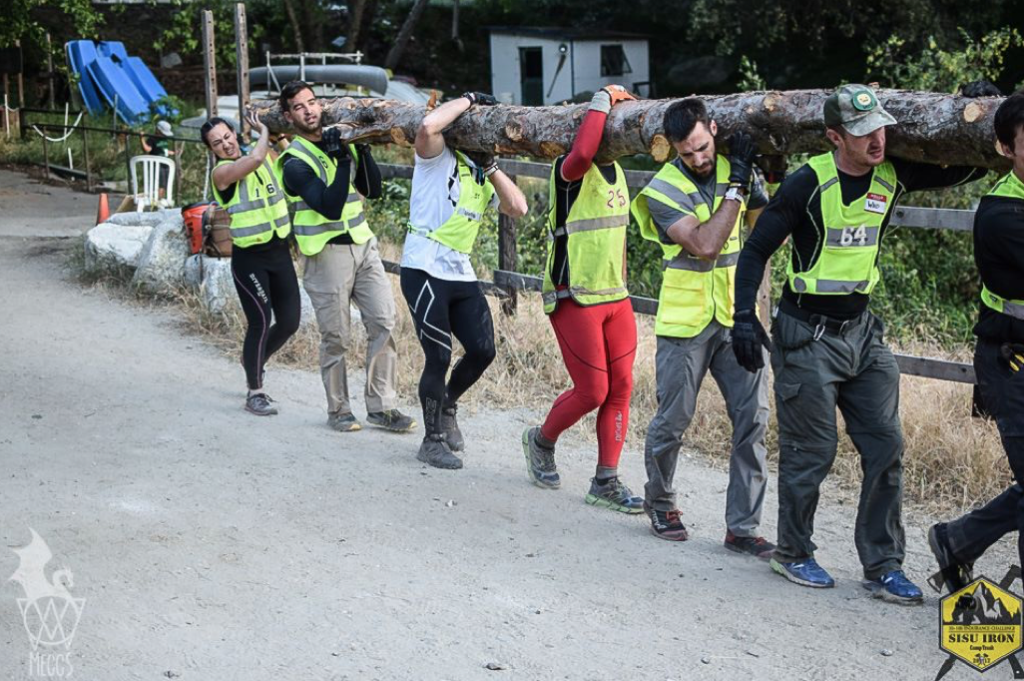
After the introductory speeches, our first task was to run down from Camp Trask to downtown Monrovia in small groups (Strava activity). Once we got there, we got in lines to do plyometric workouts while waiting for our turn to compete in recorder playing (a required gear item). Four participants played a pre-prepared song and the winner was chosen by crowd applause. I played “Flower” by Moby, which is recognized in fitness circles as “Sally” but the audience did not appreciate the reference.
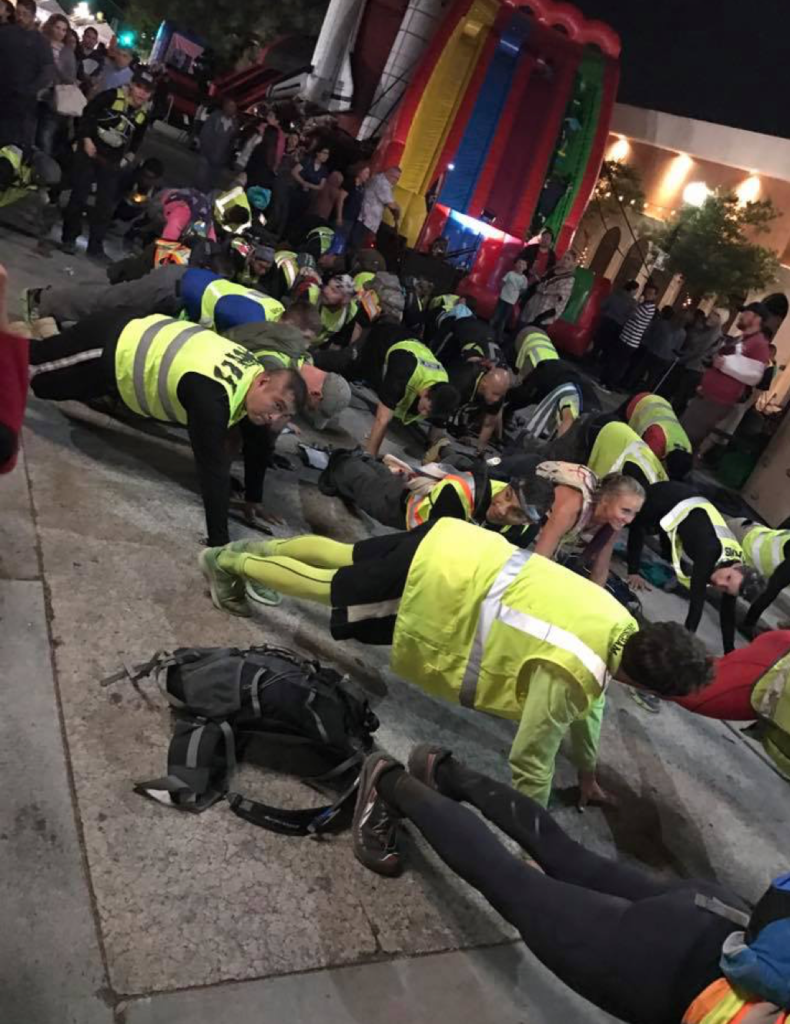
After everyone had competed, we ran to 24-hour fitness in Arcadia with a buddy (Strava activity). We were told to change into our gym shorts and place our gear into a locker using our lock. We proceeded to jump into a pool and do a large variety of pool exercises. Groups of 5 were pulled out of the pool to complete a small workout in the sauna. This was designed to dehydrate you. Eventually, we were in the pool for almost 3 hours. The first 30 minutes in a pool are fine, but when you’re in a pool for 3 hours, it sucks the heat from your body causing you to start shivering. The only way to combat that for me was to work my muscles harder so they generated more heat, but we were just 5 hours into the event. I didn’t want to build up an energy deficit already!
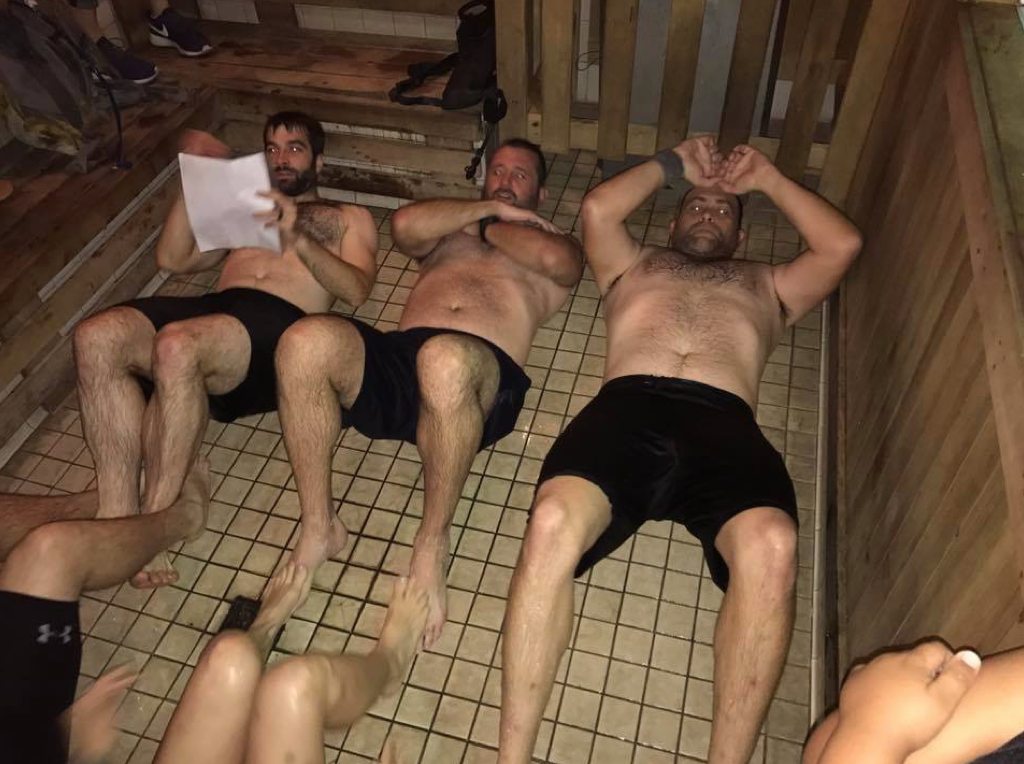
Finally we were done in the pool and our task was to run back to Camp Trask in 90 minutes. That included drying off and showering after our swim. My buddy and I knew that efficiency is key for these events, so we quickly put our shoes back on, then headed out back to camp, which was mostly uphill. We got back to camp at 1:09am, with 21 minutes to spare (Strava activity). Our finishing place for that run was placed on our chest and we were instructed to polish our wood to make sure that face was flat and smooth.
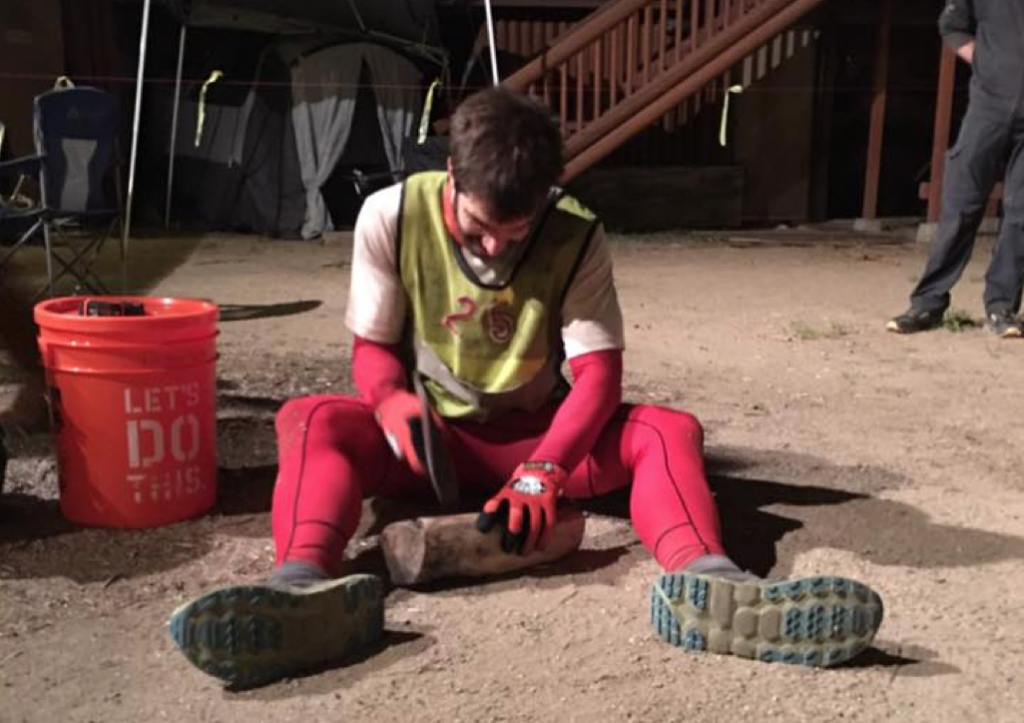
After everyone got back, we played Injinji Jenga. We were split into teams of odd finishers and even finishers. There was a giant Jenga set and the odd team competed against the even team to see who could get the tower the highest before it collapsed. The losing team got penalty burpees.
After that, we got in one big line in order. Each Jenga block had a number on it. Your task was to remove a block. The number on the block told you your partner for the next time hack. Once you removed the block, you were allowed to go start your run. I finished 2nd on the run back, so I waited to see what the 1st finisher did. He selected the #4, so I found the #3 block and ran with James Blair. We gathered all our gear and started on our hike, which was 4 miles round trip with a huge amount of elevation gain. At the turn around point, Mark Jones (Director of Athlete Morale) instructed us to choose a basketball-sized rock and bring it back to camp with us. Basketball-sized rocks are heavy! James and I are both trail runners, so we used our speed to finish that time hack quickly (Strava activity).
For our next task, we took out our axe and eye protection and were assigned logs to chop. These were the same logs we carried down from 5-7pm last night. Together, we were supposed to translate these large logs into firewood. Some of the logs were quite moist sappy, so it was very hard to split them.
We were told that we needed pack everything that we would need for an entire day because we were going on an adventure. The adventure started by running down the hill to one of the organizer’s house, so we took off. James Blair and I were running at a good pace with all our gear and were competing against each other. I got ahead on one of the large downhills, but a car tried to pass a tad too close to me, and I tripped over a bump on the road. I got launched and landed on the asphalt with my chest. I slid a distance and scraped my hand a little as my legs flew above my head, but at least I didn’t scrape my face. When we got to the organizer’s house, we saw a bus and that it didn’t matter we went fast (Strava activity). Darn.
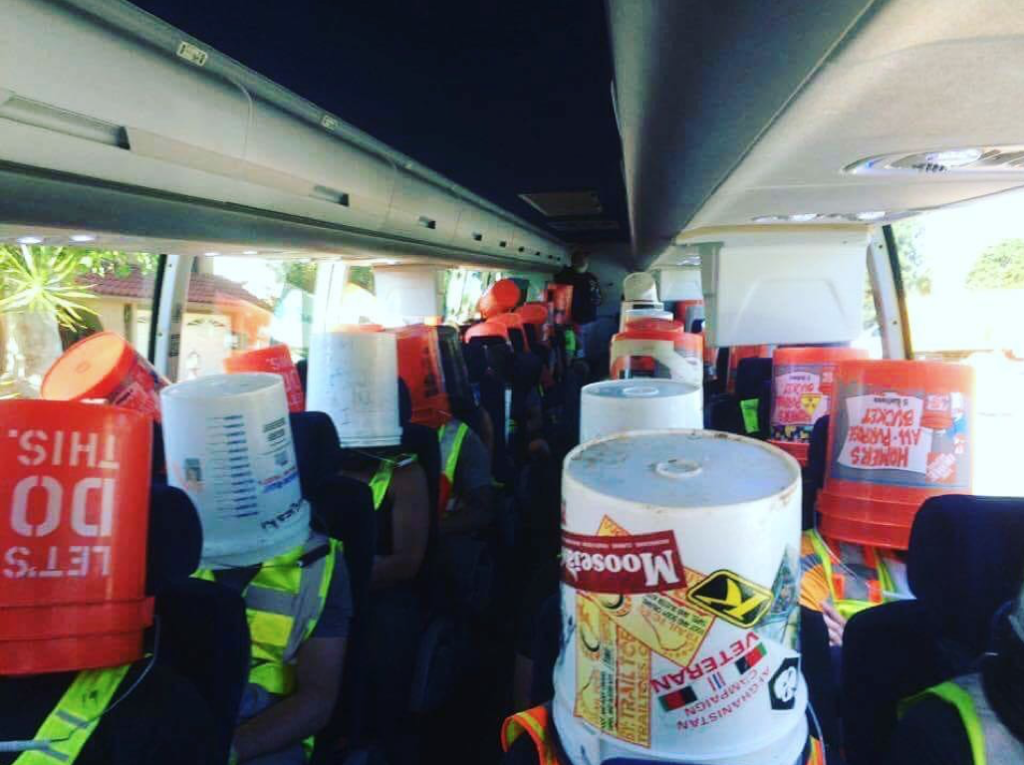
We were instructed to place our handkerchiefs over our eyes and put our 5-gallon buckets over our head. We them drove to an undisclosed location. At the undisclosed location, we had a large log and heavy bag that we needed to carry as a group to our destination. The log and heavy bag had to lead the group. We created a system of rotating people carrying these items until we reached our final resting place. Along the way, we passed a stream and we were instructed to create a human damn so that a rock upstream was submerged. This was snow runoff water. (Strava activity until my watch died)
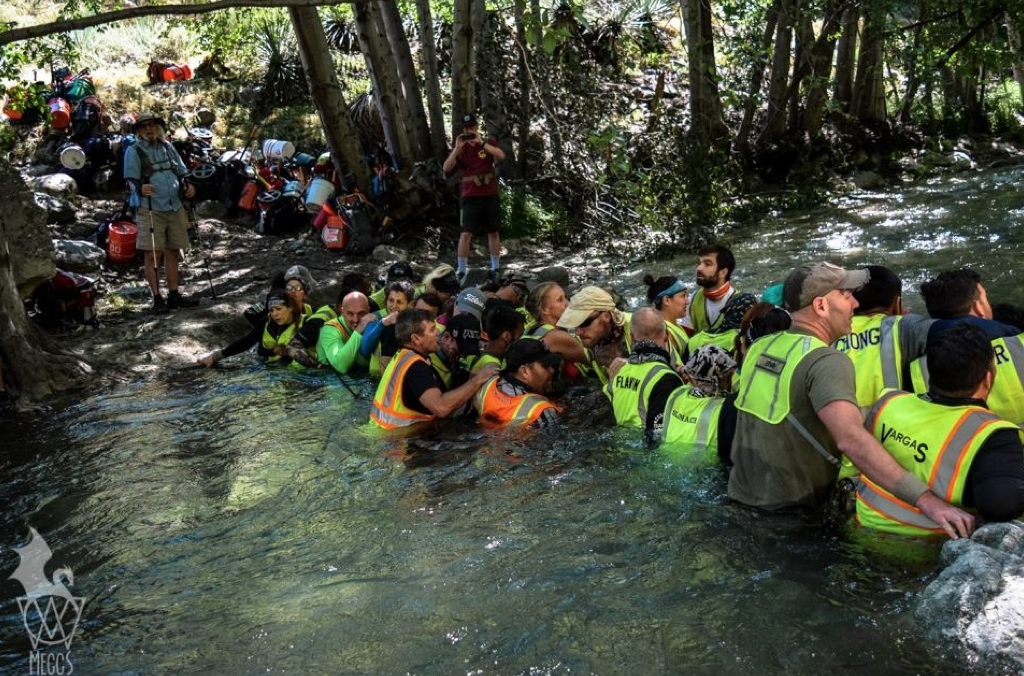
When we got to our destination, we were on the Bridge to Nowhere, one of the few legal places to bungee jump in California. We had two options: bungee jump with our extra $100 or do Bootcamp with Mark Jones down in the river. As someone who doesn’t like heights and doesn’t enjoy overcoming that fear, when I heard that a fellow racer had forgotten his $100, I eagerly donated my $100 to him and went down for Bootcamp. Around 85% of racers ended our jumping. Mark Jones had a series of 25 crazy exercises for us to do, and every 5 exercises we had to do a full submersion in the snow runoff. We were told that the person who completes the most exercises gets a prize, so my goal was to finish them all. I finished 22 before we had to leave.
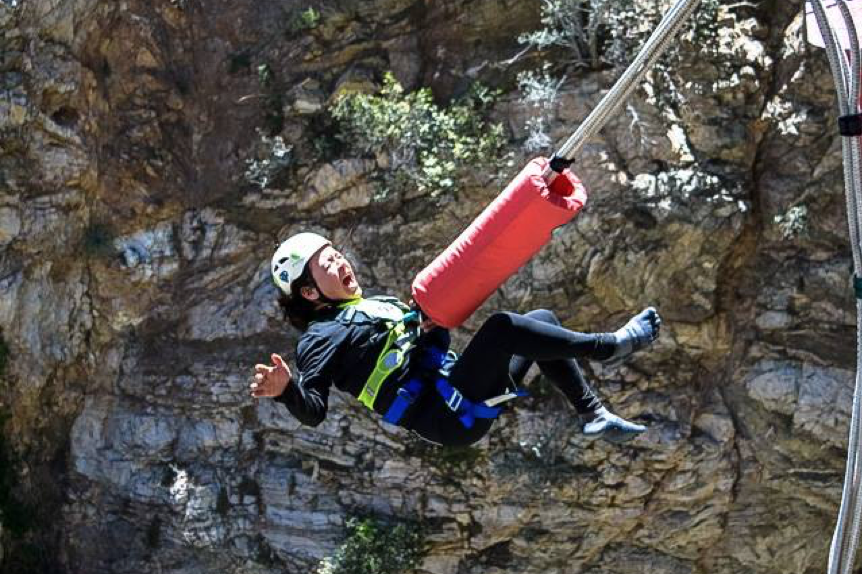
On the way back, we were told that everyone had to get back to the bus by 5pm, including the log and the heavy bag. The first 25 participants were safe from elimination. Initially, I sped off alone knowing that I could be the first back pretty easily. Within about a quarter mile, I realized that I needed to help with the log, so I stayed back and worked with a group of 6 crazy awesome guys to make sure the log got back. We ended up setting the pace standard and the log finished 10th. As we were jogging with the log, we were talking about what was going on with the heavy bag. We knew it was behind us, but we hoped and assumed that other people had taken responsibility for the heavy bag. We talked about running back to help the bag, but we were concerned about making it in time for the heavy bag. We weighed risking DNF versus getting the bag, and decided to stay. As time went on, we didn’t see the bag come back. It got suspiciously close to 5pm. Eventually the bag arrived at 4:55pm and in last place, and Don Devaney had to help it get there. Apparently, only 3 people had stayed back to help. The whole team had failed to take responsibility, so we were going to be punished.
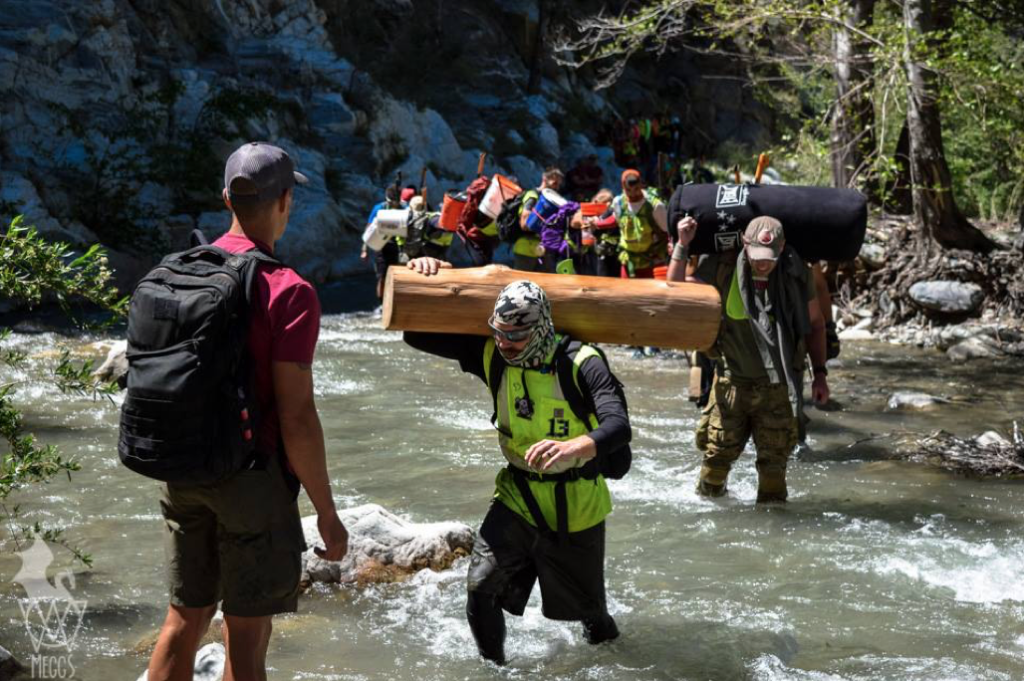
We got back in the bus without our handkerchiefs and buckets, and were driven to Pacific Coast Brewery for our next challenge. We ate raw hops and had to guess which beer it would be made into. If we got it wrong (I got it wrong), then we had to do goblet squats with a 5-gallon bucket filled with hops. Those hurt. We also were in teams of 5 where we had to suspend one person to be able to drink a shot of water.
Our next task is a classic Iron challenge: the waterfall challenge. We had to run back from the Brewery (5+ miles) to a waterfall that’s about 3 miles from camp trask. James Blair and I competed with each other to get to the waterfall. We were quite even until we got on the actual trail in Canyon Park, when I created some separation going up the hill. I ended out getting to the waterfall a couple minutes before him. We both were almost 10 minutes before the volunteers, so we got to wait in the darkness for them to arrive. We filled our 5-gallon bucket with water and started our journey back to Camp Trask. For the first 100m, we needed to carry it behind our backs, but we saw that those who were slower than us had their shoes zip-tied together for the 100m they approached the waterfall. Unfortunately, James’ bucket apparatus broke after 100m and he needed to turn back to refill his water. That’s the last I saw him. Throughout the entire event, everyone but me had a system to affix their bucket to their ruck. I simply carried it in my hands because I knew that no system would hold 48lbs of bucket-filled water. My system to get the bucket back was to affix it to my waistband on my right hip, then left hip, then bucket-carry it in front. Once my hips felt a tad bruised and raw, I started a system of carrying it for 20s in one hand, resting for 3s, then carrying it for 20s in the other hand. I repeated this for more than a mile and finished the waterfall first. James was around 10-15 minutes behind me, and the next person wasn’t back for a while.
During this break time, I had the opportunity to continue Mark Jones Bootcamp! In order to start this process, I had to dunk fully in the frog pond.
However, I quickly finished the 25 exercises and it was announced that I finished my first round. In my head, I thought, “FIRST ROUND!” It took a while to finish that first round!
After the time-hack for the waterfall had passed, we were told to write a letter and put it in an envelope. That letter would be mailed to us at a future date, and we could write anything we would want.
The next section was the crazy section that no one could have anticipated. We were blindfolded again, and were told that we had to complete exercises that were named. We were supposed to do whatever we thought the exercise was, and it didn’t matter what everyone else was doing. As long as we did what we thought it was, we’d be safe. As exercises passed, numbers were called out and people were taken from the group. We were lead, blindfolded into the frog pond, where we got dunked again. We then sat cross-legged against each other for a long time, as it seemed like the people inside the fort were still working. At this point, we had no idea if we were still in the event or not.
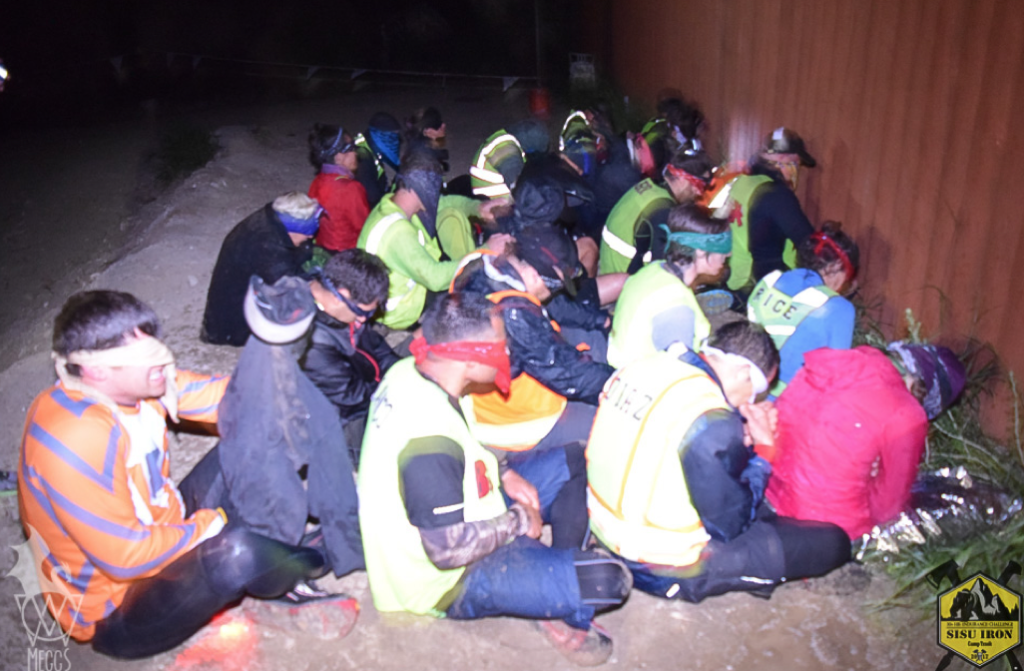
When we removed our blindfolds, we saw that we were placed into teams based on our performance: good, bad and ugly. As a team, we had to complete 4 tasks: bring a picnic table through a stream in the woods, flip 3 tires, carry 5 logs up and down a hill, and run a hay bale around a circuit. The winning team would get a small penalty, the middle team a moderate penalty and the last team an extreme penalty. You had to overcome this penalty before moving on. My team was in the middle, so we had to do a lunge quarter mile, then see Don Devaney.
Don asked me to recite the Boy Scout motto. Not being a Boy Scout, I clearly didn’t know the motto, so he sent me to study hall, where we stood in the smoke of the fire. I went up to Don and bargained with him: I’d tell him the 12 virtues of being a Boy Scout if I could be allowed to move from the study hall. He asked me how to incentivize him to allow me to do that. Since the 12 virtues were written on the steps of the amphitheater, I suggested squat jumping the amphitheater repeatedly, so that’s what I did. When I was satisfied that I had memorized them, I went back to him, and he asked me to quote them backwards. Then he asked me to say the alphabet backwards. With much difficulty, I accomplished these tasks and was released back to Mark Jone to continue completing his Bootcamp.
Around 3:30am, the second person finished the 25th exercise and opted to move on to the next task. At that point, I was told that I could move onto the next task if I wanted to, so since I had completed 40 total exercises, I knew that no one would catch up to me. Consequentially, I decided to move on and I was sent to Shane.
In the beginning of the event, we were introduced to Shane. Shane’s first speech covered some information about himself. When we got to him, he asked us a series of questions that we had to try to get right. First, we had to remember that he is from West Virginia. Next, we guessed what the main export of West Virginia is. The most common answer: moonshine! That’s also incorrect. The correct answer is coal. To find coal, we needed to dig a hole big enough to put our head in. We then had to pour our water from our waterfall bucket into the hole and put our head in the water for 1, 3, 4 or 5 minutes based on what card we chose from his hand. Of course, those were non-continuous minutes. After we finished that, we had to take the water out of our hole, because coalmines don’t have water in them, and put it back in our bucket. Of course, the ground absorbs the water so to get the water up to the level it was before we poured the water out, we had to put dirt in as well.
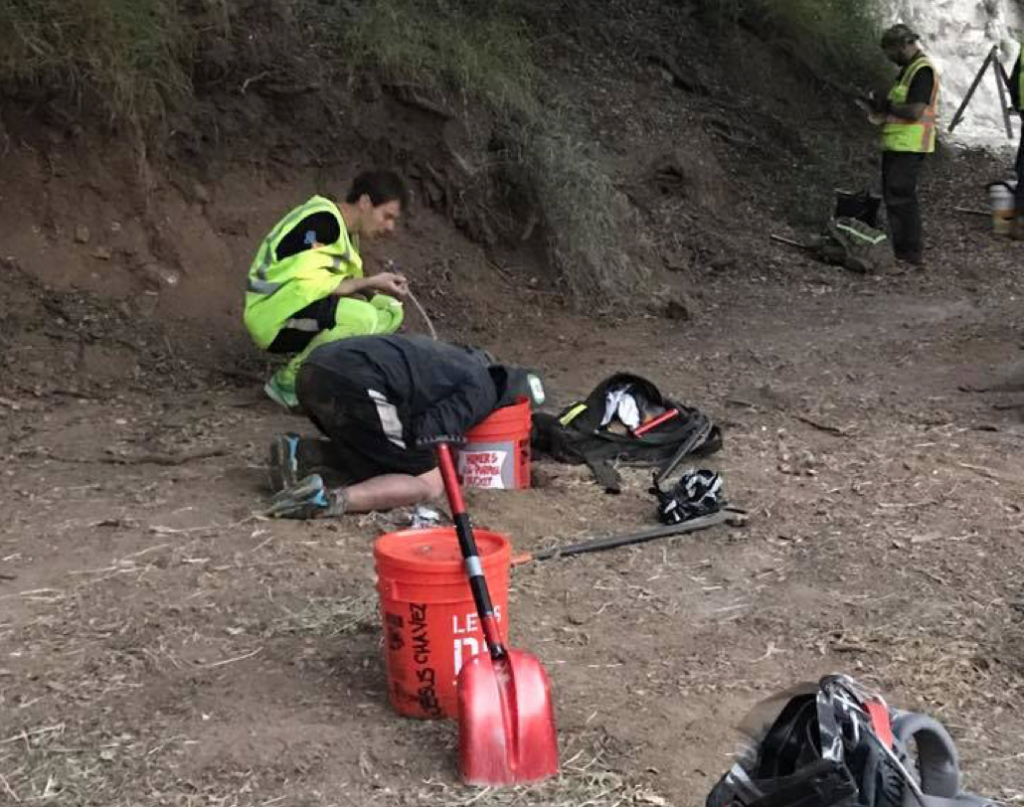
The trick was that we could have placed our bucket in the hole instead of pouring the water out, but we only figured that out after I had finished the task. One of the best strategic decisions I made during this challenge was to rent Shane’s good shovel for 100 burpees instead of my dinky shovel. Also, axes are quite effective mining tools.
Lastly, we were sent to see Lolo the Terrible. He instructed us to remove our shoes and socks, but otherwise bring our pack. We split into two teams and he told us to pick up a red kayak and, of course, we picked up a red canoe. Since we made a mistake, he then instructed us to pick up red canoes. We then walked, as a team, around a roughly 1-2 mile loop carrying the canoe without shoes. This loop included gravel, stones, twigs and prickers. It was horrible, but it ended.
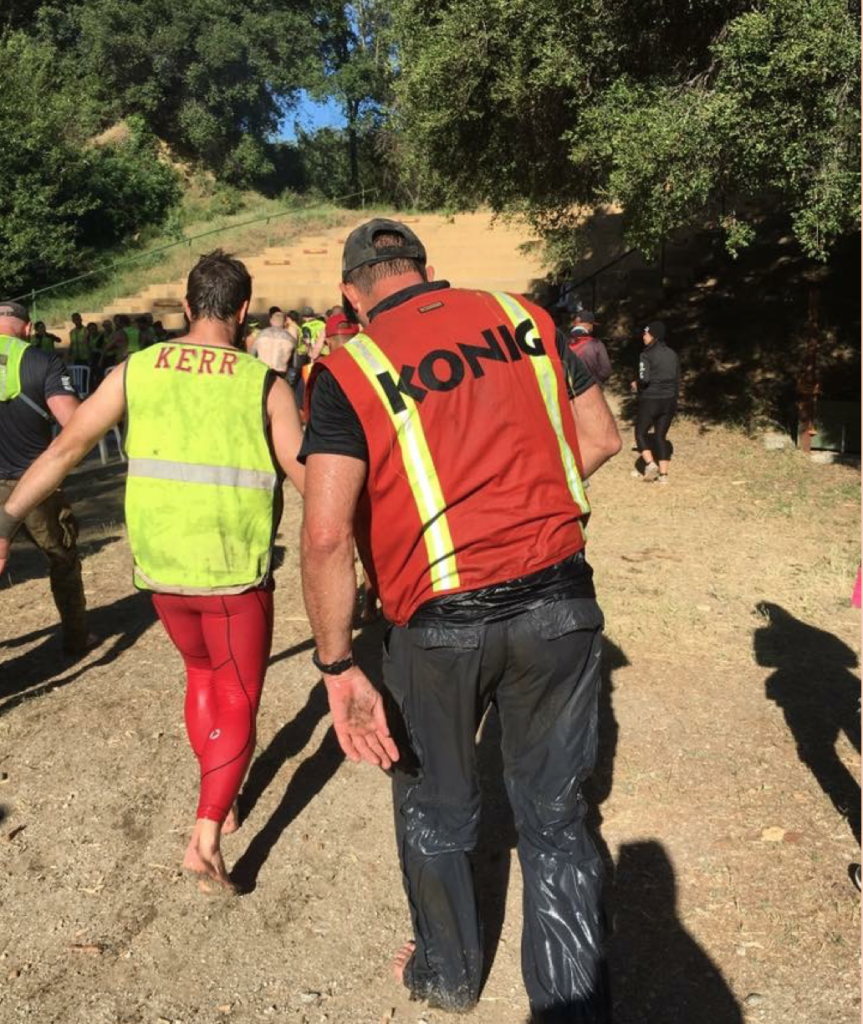
At the end of that hike, we were told that we had completed the Iron! Yay! All we had left were trophies and awards. We got our log fashioned with “SISU IRON” and hammered some nails into that log. Each finisher received an Iron spike to signify their accomplishment and there were 3 special awards. The most prestigious award from the Iron is the Ironman and Ironwoman. Instead of these being based entirely on the performance of who finished, these awards are voted on by your fellow finishers to recognize the man and woman that were most inspiring, most supportive and exemplified the qualities of SISU. This year the Ironwoman was Mindy England and the Ironman was me. The last award is the Squirrel, which was awarded by the staff for someone who had an exemplary performance, and was given to Jessica Rogers.
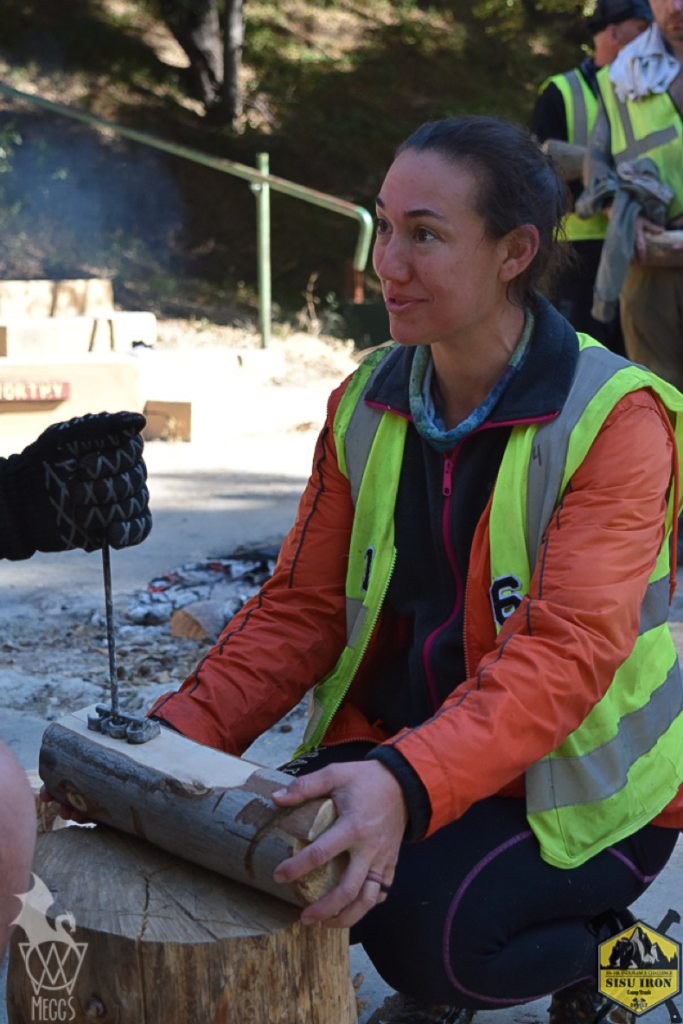
Overall, this was a 38-hour and perhaps 55-mile event that put us through new and strange challenges that I could not have predicted. With my extensive endurance racing experience, I’ve built a regimented system of how to deal with all the challenges that usual courses put in front of us. The Iron forced me to adapt to new challenges and use mental grit to get through some parts. In specific, I learned to be comfortable shivering for hours without moving much. (Moving generates heat.) This reminds me of the challenges and toughness that I felt when I first started in OCR. The Iron reminds me that I can always improve and there’s always something to work on. In addition to being great training for crazy endurance events, it’s a rare event that specifically focuses on putting yourself in the right mental space to take on crazy challenges for the rest of the year.
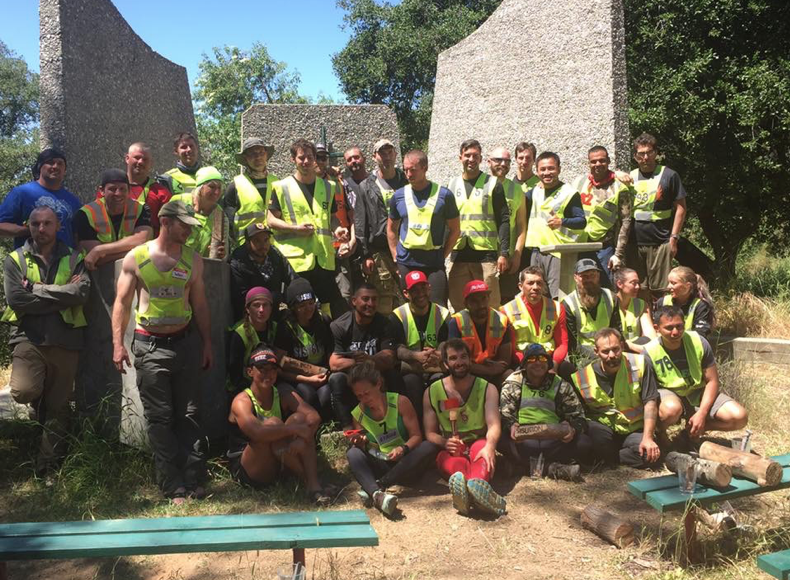


Awesome write-up! It was a blast running with you yet again. I’ll see you around the circuit even if it’s 2017 WTM at the latest.